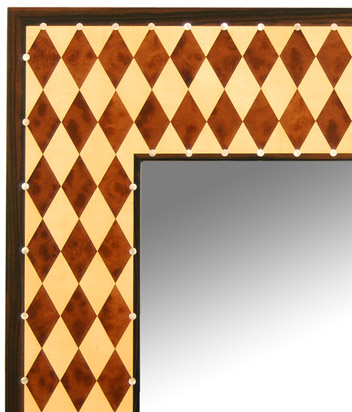General Information
The Craft of Veneering
My book on veneering is officially available (The Craft of Veneering). Published through the Taunton Press in 2018 the book covers a wide range of veneering topics from very basic to quite advanced. The intention was to create a resource of veneering information useful to both the beginner and skilled woodworker. It begins with a walk through of the process used to make veneer then progresses from simple veneering projects using a single sheet of veneer through to much more advanced subjects like marquetry, parquetry and curved veneering. The goal was to compile my many years of veneering knowledge into a single publication in the hopes that it would make the veneering process easier for future wood workers.
Commissioning
Most commissions begin with an email from a potential client interested in creating something unique. This initial back and forth communication allows us to begin creating a general design concept. Many clients have images or descriptions of pieces they enjoy that can be used to direct the style of the desired furnishing. After the overall project scope is defined through the initial discussion, an initial price and contract is presented. Once the contract has been approved and a deposit placed, I will often generate 3-D computer models for client approval. Additional computer sketches will be created, if necessary, for specific project details. These computer models enable me to work back and forth with the client to finalize a design that represents the exact desires of the individual.
The process of creating custom handmade furniture is a time consuming and detailed one. Clients are welcome to visit the shop at any time to view progress on their project. At certain times I may request that the client visit the shop to approve specific details or to help work through a particular design issue.
Pricing
Creating custom furniture is a time consuming and labor intensive undertaking. Some projects are quite simple and take little time while others take months of labor and numerous design revisions to complete. As a rough guide to pricing a simple custom designed marquetry side table could be between $5,000-$10,000 depending upon the complexity of the design and marquetry imagery. A custom dining table could be between $15,000-$25,000 again depending greatly upon the design.
My current work exploring mechanical furniture, puzzles and hidden compartments is the most expensive furniture I build due to the highly complex design and fabrication process. These pieces typically start at around $30,000 and go up from there due to the complexity of the internal mechanisms and the variety of hidden details incorporated into the design of these highly unique pieces. A good way to start is to email me so we can discuss the details of your project and budget before getting too far into the process.
Mechanical/Puzzle Furniture
The overall focus of my work has changed over the past few years as I have been commissioned to create a variety of highly complex furniture pieces incorporating automated mechanical movement and puzzle mechanisms. The mechanical movement is reminiscent of the furniture of the Roentgens from the late 18th century but with a modern twist in the form of sequential discovery puzzles designed as part of the furniture itself. On my latest pieces I’ve been collaborating with a well known puzzle maker, Robert Yarger AKA Stickman, on the puzzle designs. Robert brings a master puzzle makers vision to the projects and we have developed a smooth working relationship over the years of time spent designing and building our puzzle furniture. If you are interested in commissioning a mechanical/puzzle oriented piece of your own our combined efforts could create a unique piece to be treasured for many years, and it will be fun to play with as well.
Marquetry/Parquetry
For the past 18 years I have been incorporating marquetry and parquetry imagery in the form of flowers, branches, animals, and geometric patterns into some of my furniture. I see the addition of decorative marquetry as a doorway into unique and exiting visual forms and more expressive freedom. Marquetry/parquetry is the craft of covering a structural carcass with veneer forming decorative patterns, designs or pictures. Materials associated with marquetry typically have included wood, ivory, bone, mother-of-pearl, brass and others. My marquetry furniture combines the structural geometry of a man-made object with the asymmetry of nature represented in flower and leaf patterns and motifs.
The majority of the marquetry veneer patterns in my work are cut in the traditional 18th century method, also known as the packet cutting method. The packet method requires cutting all the elements of the design simultaneously with the background. Cutting can be done on a chevalet de marqueterie, or marquetry donkey, which is of French design and is also from the 18th century or with a modern scroll saw. Specific components are then shaded with hot sand to create the illusion of depth and shadows. The veneer work is then glued to the furniture carcass, using a combination of traditional hide glue and modern glues, including epoxy, urea formaldehyde and polyvinyl acetate.
Incorporating marquetry or parquetry images into a custom piece of furniture can add considerable time to the design and construction process, but it allows the client to possess a piece that is truly unique. Each marquetry design is hand drawn leaf-by-leaf and flower-by-flower to create imagery that flows naturally and is true to the artistic vision of the project being created. These marquetry designs typically begin with photos of the shapes and patterns of the flower and leaf design being created. The process then progresses into hand drawings that go through many revisions as the lines and shapes of the individual components of the design are finalized. These final drawings are the cutting template for the marquetry veneer packets and are used throughout the construction process to guide the design to its final finished shape.
Art Deco
Another side of my work explores the highly formal furniture of the 1920’s Art Deco era, primarily work by the designer Jacques-Emile Ruhlmann. The creation of custom furniture true to the Art Deco style requires tremendous focus and discipline and is a welcome change from the more relaxed floral decorations of my marquetry furniture. To build my Art Deco furniture I bring together luxurious materials, outstanding finishes and precise, highly refined veneer work.
Please contact me directly to discuss any of your furniture needs.



